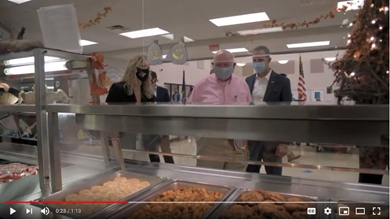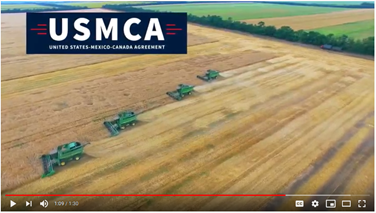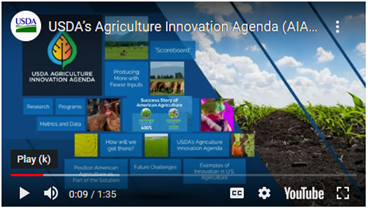USDA's 2020 Accomplishments
 U.S. Secretary of Agriculture Sonny Perdue recently applauded the accomplishments made by the U.S. Department of Agriculture (USDA) over the past year.
U.S. Secretary of Agriculture Sonny Perdue recently applauded the accomplishments made by the U.S. Department of Agriculture (USDA) over the past year.
- Read the full Press Release HERE.
(Washington, D.C., December 16, 2020) – U.S. Secretary of Agriculture Sonny Perdue today applauded the accomplishments made by the U.S. Department of Agriculture (USDA) over the past year.
“While this was a tough year with the coronavirus, historic wildfires, and weather damage, USDA met these challenges with a multitude of programs and services to support Americans and keep our agricultural sector running and responsive to the country’s needs,” said Secretary Perdue. “We salute our mission areas and agencies for keeping our customers front and center, serving the American people, farmers, ranchers, foresters, and producers.”
Farmers to Families Food Box Program:
USDA’s Agricultural Marketing Service (AMS) purchased $8.6 billion in food for delivery to food banks, churches, schools, community organizations, tribal organizations, and international food aid organizations through various programs during Fiscal Year 2020. Using Coronavirus Food Assistance Program (CFAP) funding, USDA announced the Farmers to Families Food Box Program on April 17, 2020. Through this program, USDA has been partnering with national, regional and local distributors, whose workforces have been significantly impacted by the closure of restaurants, hotels and other food service businesses, to purchase up to $4.5 billion in fresh fruits and vegetables, dairy products and meat products from American producers of all sizes. Distributors then package these products into family-sized boxes and transport them to food banks, community and faith-based organizations, and other nonprofits serving Americans in need. The Food Box Program has provided more than 125 million food boxes to Americans in need and will purchase nearly $4.5 billion worth of food by the end of the year.
Coronavirus Food Assistance Program (CFAP) Funding:
Working with the Office of the Chief Economist (OCE), the Office of the General Counsel (OGC), and the Agricultural Marketing Service (AMS); FSA and the Farm Production and Conservation Business Center quickly built and delivered two rounds of the CFAP, which provides financial assistance to help producers absorb some of the revenue losses and increased marketing costs associated with the COVID-19 pandemic. So far, CFAP 1 and CFAP 2 made available $30 billion in relief. Additionally, USDA’s Farm Service Agency (FSA) and Natural Resources Conservation Service (NRCS) worked together to adopt new processes for electronic signatures to ensure producer and field staff could use electronic tools safely and securely.
Ensuring Access to Food:
USDA’s Food and Nutrition Service (FNS) took unprecedented steps to ensure that children and low-income individuals had access to nutritious food in response to the pandemic as well. FNS issued more than 4,000 program flexibilities to adjust to local needs and maximize access for all eligible families across each of USDA’s 15 nutrition assistance programs. In October, USDA announced it would allow free meals to continue to be available to all children throughout the entire 2020-2021 school year. This unprecedented move is part of USDA’s unwavering commitment to ensuring all children across America have access to nutritious food as the nation recovers from the COVID-19 pandemic.

(Click this link - school meals announcement video to learn more about the flexibilities)
Trade:
In January, the United States and China reached a historic agreement on a Phase One trade deal that set forth structural and technical reforms to China’s trade practices in the areas of intellectual property, technology transfer, agriculture, financial services, and currency and foreign exchange. The Phase One agreement addressed many non-tariff barriers to U.S. agriculture; it also included a commitment by China to make substantial purchases of U.S. goods and services. This agreement led to a record pace of Chinese purchases in many sectors, boosting agricultural commodity prices. In July, The United States-Mexico-Canada Agreement (USMCA) entered into force, replacing the decades-old NAFTA, expanding market access for U.S. farmers to sell their products to our closest neighbors. In ongoing engagements with the European Union, and as the U.S. pursues a post-Brexit free trade agreement with the United Kingdom, Secretary Perdue and USDA called for transparent, science-based trade policies that foster innovation and ensure that agriculture remains economically, environmentally and socially sustainable.

(Click the link to view the USMCA video)
Customer Service:
USDA’s Farm Service Agency (FSA) stood up a call center to help producers with questions and assistance with program applications for CFAP and Seafood Trade Relief Program. The call center has received over 25,000 calls, including over 800 in Spanish, since its inception in May. In just two weeks, the Farm Production and Conservation Business Center developed and deployed a new tool that walks producers through eligible commodities for CFAP and outlines their next steps. Another new decision tool, the Conservation Concerns Tool, gives landowners conservation solutions to fit their business needs. In addition to searching for information on farmers.gov, producers can also log into farmers.gov to manage their conservation business online.
Rural Broadband:
USDA invested $1.3 billion to support rural broadband expansion through the ReConnect Pilot Program. Included in this total is $85 million provided through the CARES Act. In total, these investments are connecting approximately 280,000 households, 19,978 farms and 10,053 businesses to high-speed internet.
Innovation and Sustainability Agenda:
Through the Agriculture Innovation Agenda, USDA committed to stimulate innovation so that American agriculture can achieve the goal of increasing U.S. agricultural production by 40 percent while cutting the environmental footprint of U.S. agriculture in half by 2050. The initiative is comprised of four main components; developing a research strategy; aligning the work of our customer-facing agencies and integrating innovative technologies and practices into USDA programs; setting benchmarks to track progress toward meeting future food, fiber, fuel, feed and climate demands. As one example of Agriculture Innovation Agenda efforts, USDA, the U.S. Environmental Protection Agency (EPA) and the U.S. Food and Drug Administration (FDA) are working together to deliver on the U.S. national goal of reducing food loss and waste by 50 percent by 2030 through consumer education, food date labeling, measurement, and collaboration with private industry.

(Click the link to view the Agriculture Innovation Agenda video)
USDA Agency Accomplishments:
USDA serves the American people at more than 4,500 locations across the country. While each mission area accomplished a great deal in 2020, notable accomplishments are as follows:
Agricultural Marketing Service (AMS) purchased $8.6 billion in food for delivery to food banks, churches, schools, community organizations, tribal organizations, and international food aid organizations through various programs during Fiscal Year 2020. Using Coronavirus Food Assistance Program (CFAP) funding, USDA partnered with national, regional and local distributors, whose workforces were significantly impacted by the closure of restaurants, hotels and other food service businesses, to purchase and distribute agricultural products to American families across the country. The food was packaged and distributed through the innovative Farmers to Families Food Box Program, begun in May. The food box program has provided more than 125 million food boxes to Americans in need and will purchase nearly $4.5 billion worth of food by the end of the year. In addition, AMS purchased $1.3 billion worth of American-produced agricultural products through the Food Purchase and Distribution Program (FPDP), one of three USDA trade mitigation programs aimed at assisting farmers suffering from damages caused by unjustified trade retaliation by foreign nations. AMS also continued its support for the nation’s food safety net through its regular, ongoing Section 32 purchases of a variety of domestically produced and processed agricultural products. Approximately $700 million in Section 32 purchases were made for The Emergency Food Assistance Program (TEFAP) this year, of which over $496 million in purchases are scheduled for delivery in FY 2021.
Agricultural Research Service (ARS) scientists identified a promising, highly effective new vaccine that protects against the circulating strain of African Swine Fever that is affecting the pork industry in Europe and Asia. In just two months, ARS researchers produced the entire genome of the Asian giant hornet, a new invasive insect that is a threat to honey bee colonies. ARS made the data freely accessible to researchers even before publishing in a scientific journal to help coordinate an effective and rapid response. ARS scientists also designed the scent lure for traps that led to the detection and destruction of the first nest of these invasive insects in the United States. To help inform livestock and poultry producers, ARS initiated emergency response research on SARS-CoV-2; the research demonstrated that livestock and poultry species are not a source of infection for SARS-CoV-2 and insects are not a risk factor for the transmission of the virus to humans.
Animal and Plant Health Inspection Service (APHIS) played a vital role to ensure the free flow of agricultural trade by keeping U.S. agricultural industries free from pests and diseases. Examples include eradicating a disease-causing bacteria (Ralstonia solanacearum race 3 biovar 2) from more than 650 U.S. commercial greenhouses in just two months; eradicating an outbreak of avian influenza in North and South Carolina, preventing spread to other areas and limiting the overall impact on the poultry industry; publishing the final SECURE rule, the first-ever major revision of USDA’s biotechnology regulations, which streamlines and modernizes our system; and establishing the first-ever robust foot-and-mouth disease vaccine bank.
Economic Research Service (ERS) produced timely economic research and data to address emerging national and global issues. Among these efforts, Commodity Outlook reports on how the pandemic has affected commodity markets, as well as contributions to the new U.S. Census Bureau Household Pulse Survey, which provides near real-time data on households experiencing food insufficiency, or not having enough food, among other measures. Other ERS research helps decision makers with emerging issues, such as a study on how the European Commission’s new Farm to Fork and Biodiversity Strategies might affect agricultural production and food security. ERS also coordinated with the National Agricultural Statistics Service to conduct the Survey of Irrigation Organizations, which will provide the first data in more than 40 years on the operation of surface-water delivery and groundwater management organizations and their influence on on-farm water use and drought resiliency of the irrigation sector.
Farm Production and Conservation (FPAC) Business Center streamlined processes and improved mission support delivery, which enables staff of USDA’s Farm Service Agency, Natural Resources Conservation Service, and Risk Management Agency to continue providing best-in-class customer service and delivery of farm programs. The Business Center improved fleet management through enhanced reporting tools and new processes for vehicle-sharing, decreasing underutilized vehicles in the fleet by 21 percent in recent years. The Business Center has also provided critical support – from software to rulemaking – for the implementation of programs, including the Coronavirus Food Assistance Program 2, which was developed and deployed in six weeks. The Business Center has also led development of farmers.gov, a single web experience that provides farmers, ranchers, and forest landowners with self-service applications and program information.
Farm Service Agency (FSA) helped farmers, livestock producers and foresters weather a tough 2020, marked with a pandemic and natural disasters. This included delivering two rounds of the Coronavirus Food Assistance Program (CFAP), which to date has made available $30 billion to help producers absorb some of the increased marketing costs associated with the COVID-19 pandemic. FSA’s suite of disaster assistance programs provided more than $212 million to help offset losses from the year’s wildfires, hurricanes, and drought. FSA also helped farmers and ranchers get the financing they needed to start, expand or maintain a family farm, obligating more than $7.5 billion in direct and guaranteed farm ownership and operating loans, the highest in agency history. This includes more than $3.4 billion for beginning farmers, also an agency record.
The Food and Nutrition Service (FNS) responded to the COVID-19 pandemic in many ways, including Emergency Meals to You, a public-private partnership which delivered more than 40 million meals to approximately 400,000 children in rural areas during Spring and Summer 2020 school closures. FNS also stood up a new version of food assistance called Pandemic EBT, to cover the cost of meals children would normally receive at school. FNS quickly expanded access to online purchasing for more than 97 percent of Supplemental Nutrition Assistance Program (SNAP) participants in 46 states and the District of Columbia. FNS continues to work with interested states and retailers, with a priority on independently owned and operated retailers. This year also realized key policies in line with the agency’s commitment to customer service, program integrity and self-sufficiency, including the first ever SNAP Employment and Training (E&T) National Work Forum, bringing together more than 1,500 partners nationwide to discuss ways to move SNAP participants forward into work opportunities.
Food Safety and Inspection Service (FSIS) advanced science-based and data-driven initiatives to modernize policies, operations, and inspection systems. Among them, a regulatory change that modernizes swine slaughter inspection which establishments can choose to operate under, as well as finalizing the Egg Products Inspection Regulations rule, the first time that egg product inspection methods have been modernized since Congress passed the Eggs Product Inspection Act in 1970. During the COVID-19 pandemic, FSIS protected its employees by supplying and requiring the use of protective equipment as outlined in guidance from the Centers for Disease Control and Prevention (CDC). FSIS continued to fulfill its Congressionally mandated mission to ensure the safety and wholesomeness of meat, poultry, and egg products provided to consumers. No FSIS-regulated establishments closed due to a lack of inspection personnel.
USDA’s Foreign Agricultural Service supported policy and marketing channels to promote free, fair and reciprocal trade and to expand opportunities for U.S. agriculture in the global marketplace. The historic Phase One trade agreement with China, addresses a multitude of structural barriers that had impeded exports of U.S. food and agricultural products. The United States also strengthened ties with its North American neighbors and expanded opportunities for U.S. agriculture via the landmark U.S.-Mexico-Canada Agreement (USMCA), which entered into force in July, and made substantial progress towards a free trade agreement with Kenya, while also successfully resolving longstanding trade issues there. The pandemic changed the way U.S. agriculture conducted business and interacted with international audiences, underscoring the value of USDA’s ongoing efforts to provide vital market intelligence to U.S. stakeholders and also leading to the development of innovative new marketing channels such as virtual trade shows that are allowing U.S. exporters to connect directly, yet safely, with potential overseas customers.
USDA’s Forest Service (USFS) opened hundreds of thousands of acres of national forests to visitor access and sold more timber than it has in the past 22 years, providing a sustainable flow of forest products and supporting rural economies. In addition, the agency improved forest conditions and reduced wildfire risk on over 2.2 million acres through timber harvest, removing hazardous fuels like dead and downed trees, and combating disease, insect and invasive species infestations. The Forest Service is working more closely than ever with tribes, states, and local partners through Shared Stewardship Agreements to make sure the right work happens in the right place at the right time. So far, 44 states and territories are involved, and agreements have resulted in increased forest resiliency, safer communities, reduced wildfire risk, job production, and stabilized economies.
National Agricultural Statistics Service (NASS) delivered on its mission to provide timely, accurate, and useful official federal data to the public on nearly all aspects of U.S. agriculture. NASS released nearly 400 scheduled reports, including many topics connected to the 2017 Census of Agriculture. The agriculture census is the only source of uniform, comprehensive, and impartial agriculture data for every county in the nation. These deep-dive reports looked at states and counties; race, ethnicity and gender; market value of agricultural products; congressional districts; Navajo nations; organics; American Indian Reservations: watersheds; and specialty crops. NASS also released results of the censuses of agriculture for Puerto Rico, Guam, the Northern Marianas Islands, American Samoa, and the U.S. Virgin Islands. NASS added an open-access, customizable, web-based geospatial tool called Crop Condition and Soil Moisture Analytics (Crop-CASMA) to its geospatial portfolio. Crop-CASMA produces near real-time topsoil and subsoil moisture data aligned with NASS’s weekly crop progress reporting calendar.
National Institute of Food and Agriculture (NIFA) awarded $24 million in grants for universities, colleges, small business, technical schools and youth development programs, such as 4-H, to spur rapid response innovation addressing the pandemic. To expand the pipeline of tomorrow’s agricultural scientific and professional workforce, NIFA awarded grants, scholarships, and Centers of Excellence designations to minority-serving colleges and universities. NIFA and the National Science Foundation announced seven new artificial intelligence institutes across the country to accelerate research, expand America's workforce and transform society for the future. NIFA awarded 12 grants totaling more than $7 million to initiate research on big data analytics, machine learning, artificial intelligence, and predictive technologies needed to keep U.S. agriculture on the leading edge of food and agricultural production.
Natural Resources Conservation Service (NRCS) worked with agricultural producers to develop more than 100,000 conservation plans as well as place conservation practices and enhancements on more than 19 million acres through the Environmental Quality Incentives Program (EQIP) and Conservation Stewardship Program (CSP). NRCS helped producers protect more than 230,000 acres of wetlands, grasslands and prime farmlands with conservation easements. NRCS also works closely with conservation partners and other organizations to spur innovation and to increase impacts of conservation. In October, NRCS awarded more than $14.6 million in Conservation Innovation Grants to 24 projects, generating more than $15.3 million in partner matching funds.
The Office of the Chief Economist (OCE) developed estimates of COVID-19-related damages to the U.S. agricultural sector; these estimates were then used to develop payment rates for the Coronavirus Food Assistance Programs. In addition, OCE estimated impacts of adverse weather on agricultural producers to assist Departmental decision making on drought, hurricanes, derecho, and wildfires. OCE’s World Agricultural Outlook Board coordinated and developed USDA’s annual 10-year agricultural commodity projections and the monthly World Agricultural Supply and Demand Estimates (WASDE), the most widely used source for domestic and global commodity market estimates and forecasts available. OCE coordinated USDA’s Agricultural Outlook Forum, USDA’s premiere annual event, which drew more than 1,800 participants. OCE provided input on numerous rulemakings -- including more than 140 pesticide-related EPA documents -- which ensured consideration of agricultural interests.
The Office of Partnerships and Public Engagement (OPPE) hosted more than 50 statewide community prosperity summits to focus on solutions to challenges facing rural and underserved communities and connect them to the education, tools, and resources available to them through USDA programs and initiatives. In 2020, OPPE also connected hundreds of faith-based, youth, military, and community organizations to distributors to form partnerships through the Farmers to Families Food Box Program during COVID-19. This year, OPPE reestablished the Advisory Committee on Minority Farmers; the USDA-1890 Land-Grant Universities Task Force; the USDA-1994 Tribal College Leadership Group; and the USDA-Hispanic Association of Colleges and Universities Leadership Group. OPPE awarded more than $19 million across 50 nonprofits, institutions of higher education, and tribes that support socially disadvantaged and veteran farmers and ranchers.
Through the Office of Tribal Relations (OTR), USDA remains committed to Indian Country through broad intergovernmental and outreach efforts. The Office of Tribal relations has helped ensure that policy makers at USDA are aware of challenges and barriers to programs to Indian Country and work quickly to ensure that programs and services do not have an adverse impact on tribes, tribal organizations or tribal citizens. USDA is committed to upholding its government-to-government relationship through consultations on topics ranging from the Food Distribution Program on Indian Reservations to industrial hemp.
USDA’s Research, Education, and Economics Mission Area (REE) released the USDA Science Blueprint, which will set the vision for USDA’s scientific research for the next five years. USDA’s agricultural research is vital to helping our farmers, ranchers, producers, and foresters increase efficiency and productivity, and our science agencies play an integral role in setting new visions for innovation through their work. This will serve as a roadmap to guide scientific collaborations across USDA and with our partnering research organizations.
Risk Management Agency (RMA) administered crop insurance to help agricultural producers weather this year’s many natural disasters. In 2020, federal crop insurance provided more than $113 billion in total coverage, and to date, has paid out more than $5.8 billion in indemnities. RMA worked diligently to maximize flexibilities to help producers better cope with the impacts of the COVID-19 pandemic. This included extending deadlines, waiving certain requirements and deferring interest. RMA also worked with Approved Insurance Providers (AIPs) to ensure continuity of crop insurance services such as processing policies, claims, and written agreements. And finally, RMA has rolled out new coverage options, including those that help producers impacted by hurricanes, as well as expanded options for hemp producers.
Rural Development (RD) invested in a range of services and programs to support rural America. The ReConnect Pilot Program invested $1.3 billion for rural broadband expansion to connect approximately 280,000 households, 19,978 farms and 10,053 businesses to high-speed internet. RD invested a record $6.3 billion in 125 projects to upgrade or build electric infrastructure. Another $2.1 billion will expand access to safe drinking water and improve wastewater management systems for 2.1 million rural Americans. The Business and Industry (B&I) Loan Guarantee Program brought $1.7 billion to 384 rural businesses; these investments created or saved nearly 18,000 jobs. The Community Facilities Programs funded the construction or modernization of 1,683 essential community facilities such as rural hospitals, educational institutions and public safety facilities, benefiting 20 million rural residents, across all 50 states, Guam, Virgin Islands and the Western Pacific. The Distance Learning and Telemedicine Grant Program invested $71.5 million in 116 projects to benefit 12 million rural residents.
USDA is an equal opportunity provider, employer and lender.
More Information
To find the latest information on CFAP 2, visit farmers.gov/CFAP or call 877-508-8364.
Source: USDA https://www.usda.gov/media/press-releases/2020/12/16/secretary-perdue-applauds-usdas-2020-accomplishments
Additional Resources
- AACI issue update - October 19, 2020
- USDA Announces CFAP 2 with Additional aid to farmers
- AACI Issue update - USDA's Coronavirus Food Assistance Program (CFAP) update
- CFAP $19 billion may still not be enough
- From the USDA: Additional Commodities now eligible for CFAP
- USDA Announces eligible commodities for CFAP
- USDA Chart on CFAP eligibility
- CFAP final rule
- CFAP Cost-benefit analysis
- VIDEO: Explanation of payment calculations
- USDA's CFAP Website
- Read additional USDA FSA News Releases
- See all RMA Manager's Bulletins for more detailed information.
